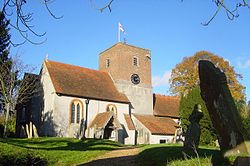Upton Grey
| Upton Grey | |
| Hampshire | |
|---|---|
 St Mary's church | |
| Location | |
| Grid reference: | SU699482 |
| Location: | 51°13’43"N, 1°0’3"W |
| Data | |
| Population: | 608 (2011) |
| Post town: | Basingstoke |
| Postcode: | RG25 |
| Dialling code: | 01256 |
| Local Government | |
| Council: | Basingstoke and Deane |
| Parliamentary constituency: |
North East Hampshire |
Upton Grey is a village in Hampshire, in the north of the county, on the line of an ancient Roman road, the Chichester to Silchester Way.
The village's suffix, Grey, derives from the years when the village was owned by the de Grey family and was used to differentiate the village from the many other Uptons.
The village has one pub, The Hoddington Arms.
St Mary's Church
Monuments in St Mary's, Church include an alabaster wall monument to Dorothy Bulstrode, Lady Eyre (1592-1650), a lady in waiting to Queen Anne of Denmark, wife of King James VI and I, with her portrait bust and heraldry.[1]
History
The Manor House dates from Elizabethan times when the Matthew family lived there. The infamous Elizabethan poet, George Puttenham, lived at Herriard House but also had a farm at Upton Grey. It was there that, at least according to his wife in their divorce proceedings, he kidnapped a seventeen-year-old serving girl in London and held her as a slave to slake his lust upon her, until Puttenham's wife discovered her and released the girl.[2]
Buildings
Manor House
Charles Holme purchased several houses and a great deal of the surrounding land in Upton Grey. The Old Manor House, which he rented to tenants for the rest of his life, was in fragile condition. Holme then commissioned a local architect Ernest Newton to refurbish it, keeping many of the original timbers. Today's Edwardian decoration encloses oak rooms, a 16th-century staircase and original roof timbers. Newton's house was finished in 1907. Gertrude Jekyll created a four and a half acre garden around it.
Hoddington House
Hoddington House is a Grade II* Listed mansion built around 1700 by John Limbrey. Described by Nikolaus Pevsner as ‘by far the best house’ in Upton Grey, it is built on the site of a religious house called Edyndon, a monastery affiliated to the Abbey of Beaulieu in the New Forest.[3] It was the childhood home of George Sclater-Booth, 1st Baron Basing and his brother, the naturalist Philip Sclater, and was sold in c1945 to Sir Edmund Stockdale, 1st Baronet.
Outside links
| ("Wikimedia Commons" has material about Upton Grey) |
References
- ↑ A History of the County of Hampshire - Volume 3 pp 382-386: Parishes: Upton Grey (Victoria County History)
- ↑ May, Stephen W (2008). "George Puttenham's Lewd and Illicit Career". Texas Studies in Literature and Language (University of Texas Press) 50 (2). doi:10.1353/tsl.0.0001. http://www.britannica.com/bps/additionalcontent/18/32819294/George-Puttenhams-Lewd-and-Illicit-Career.
- ↑ Property details http://search.knightfrank.com/cho100437
- Hart, Trevor: 'St Mary's Church and the Community of Upton Grey' (2009) (available from the church and village shop)
